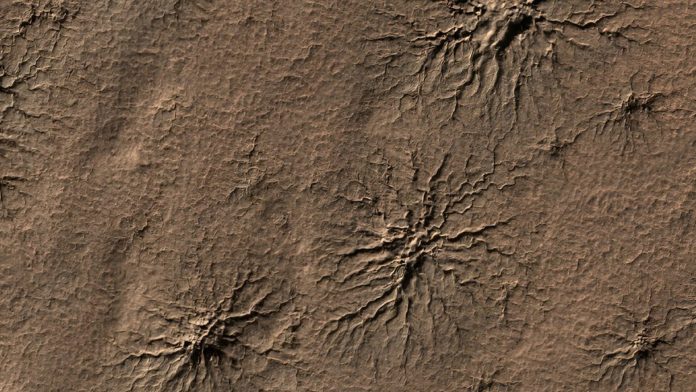Unveiling Mars’ Mysterious Spider-Like Structures: What NASA Discovered!
SCARS on the surface of Mars have stumped scientists for years – but the answers might just lie in a unique experiment by NASA.
The enigmatic spider-like **araneiform terrain** on Mars has intrigued experts since the first detailed images from orbiters in 2003. These fascinating formations are predominantly found in the southern hemisphere of Mars and can extend over half a mile, boasting intricate branches that resemble the legs of a spider.
What Are Araneiform Terrain?
The term **araneiform terrain** refers to these bizarre formations that appear to be etched into the Martian landscape. Scientists believe they may have uncovered the secrets behind these geological marvels, suggesting their creation is linked to a cycle involving carbon dioxide ice, a substance not previously recognized on Earth until recent discoveries.
NASA’s Groundbreaking Mars Simulation Experiment
A team of scientists from NASA undertook a fascinating experiment to recreate conditions akin to those on Mars, attempting to simulate the processes behind the formation of these structures. Their findings, published in The Planetary Science Journal, bolster the long-accepted Kieffer model, which explains seasonal transformations on Mars’ surface.
In this model, sunlight penetrates through slabs of carbon dioxide ice, which accumulate each winter. The soil beneath absorbs this heat, initiating a process called sublimation, where ice transitions directly into gas without melting into liquid. This buildup of gas creates immense pressure, causing the ice to fracture and releasing dark dust that collects on the surface as it escapes.
Recreating Martian Conditions on Earth
The scientists faced the monumental challenge of simulating the ~-301°F (~-185°C) temperatures and low air pressure found on Mars. Enter the **Dirty Under-vacuum Simulation Testbed for Icy Environments**—a barrel-sized chamber affectionately dubbed **DUSTIE** at NASA’s Jet Propulsion Laboratory.
In this remarkable setup, researchers chilled a Martian soil simulant in liquid nitrogen and placed it inside the DUSTIE chamber. They then reduced the air pressure inside the chamber to mimic the lower atmosphere of Mars’ southern hemisphere.
The Formation Process of Spider-Like Structures
As the temperature and pressure conditions settled, carbon dioxide gas transitioned into ice over three to five hours. The team then introduced a heater beneath the simulant, gradually melting the ice and triggering a surprising reaction.
Lead author Lauren Mc Keown experienced a startling moment when dark plumes of gas erupted through the simulant. “It was late on a Friday evening, and the lab manager burst in after hearing me shrieking,” she recounted, fearing a disaster had occurred.
The gas, under pressure, tore through the simulant, scattering debris while simultaneously forming new ice between grains—a process not accounted for in the original Kieffer model.
Next Steps and Ongoing Research
Future experiments are set to further refine these findings by simulating sunlight from above rather than below, aiming to pinpoint the exact conditions needed for the formation of these captivating “spider” structures. But excitingly, major questions remain, including whether these scars represent remnants of a vastly different Martian climate.
The Harsh Conditions of Mars
Despite ongoing exploration by the Curiosity and Perseverance rovers, the southern hemisphere of Mars has proven elusive. Even the Phoenix lander, operating in the northern region, succumbed to the brutal cold and lack of sunlight.
Fascinating Facts About Mars
While we seek to understand these intricate formations, here’s what you might find intriguing about the red planet:
- Mars is the fourth planet from the Sun, known for its reddish hue.
- Named after the Roman god of war, it has been a subject of fascination for centuries.
- Its landmass is similar to that of Earth, albeit with a lower gravity allowing you to jump three times higher.
- The tallest volcano in the Solar System, Olympus Mons, resides here, towering three times higher than Mount Everest.
- With its intriguing climate, Mars is considered the second most habitable planet after Earth.
- An orbit around the Sun takes Mars approximately 687 Earth days.
- Its diameter measures 4,212 miles, sitting on average 140 million miles from Earth.
- Martian temperatures can swing drastically, reaching as high as 70°F (20°C) and plummeting to -225°F (-153°C).
As we unveil the secrets of Mars, each discovery enriches our understanding of this alien world and our place within the cosmos. The ongoing research into Martian formations like the araneiform terrain not only captivates but also reminds us of the mysteries still waiting to be unraveled.

